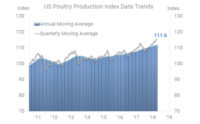Guest Commentary | Business Strategies
Go slow on slow-growth chickens

If you haven’t heard the hullabaloo about slow-growth chicken, now is the perfect time to tune in to the topic because proponents of the latest trend have not been slow to speak.
There is a vocal group of animal-rights organizations calling for a transformation of the broiler-chicken industry, asking producers to transition to so-called slow-growth birds, chickens that take longer to reach maturity than their conventionally raised counterparts.
Despite the noise, there’s little evidence on how a transition would affect either animal welfare or food sustainability. Proponents say it would be better for the birds, but the science to adequately support this theory doesn’t exist. Everyone invested in building a more humane, sustainable world should be reticent about pushing for slow-growth chicken before the science is known.
A small group of food companies have committed to selling slow-growth chicken, but many farmers and animal-welfare experts are concerned about the implications. Transitioning the poultry industry to raising a different type of bird will require re-imagining virtually everything involved with raising chickens.
A comprehensive overhaul of this type comes with significant tradeoffs — for the birds and for the environment. Right now, there is no consensus on what constitutes “slow” growth. It might just be an additional week, or it could take nearly twice as long to raise a slow-growth bird. It depends on the breed.
Raising chickens for an additional two weeks significantly increases negative environmental impacts. Those birds would produce less meat but require more resources. If one-third of U.S. broiler-chicken producers switch to slow-growth birds, farmers will need to raise roughly 1.5 billion more birds every year.
Feeding these birds will require 7.6 million additional acres of farmland per year — roughly the size of Maryland. They will need an additional 1 billion gallons of clean water to drink each year and produce more than 28 billion pounds of manure annually. They also will require more money and resources for additional buildings and the energy to run them, just to produce the same amount of food.
Some also caution slow-growth birds might have poorer welfare outcomes. These birds may be more susceptible to diseases or have higher mortality rates on farms. The truth is, we just don’t know yet.
Just because something seems good doesn’t mean it is good.
At American Humane, the country’s first national humane organization, we care deeply about the welfare of animals on America’s farms and ranches. We operate the oldest and largest farm animal-welfare certification program in the United States.
Our focus as we evaluate a farm’s operation is to answer one question: Are the animals being raised humanely? We don’t answer this question based on a gut reaction or emotion, but rather by relying on scientific research compiled, dissected and analyzed by our Scientific Advisory Committee.
At the moment, there isn’t a scientific consensus on whether raising slow-growth birds is more humane than raising animals that mature more quickly, but we’re seeking additional research on the topic. It is also not evident what the welfare outcomes of slow growth will be for birds and this, of course, is of paramount importance.
One study, conducted by researchers at the University of Guelph, is monitoring 10,000 chickens to measure welfare and health outcomes of slow-growth birds. This is a good start, and we welcome more studies of its kind before we advocate for any dramatic changes.
This is not to say birds that grow more slowly are a terrible idea or that transitioning to slower-growing breeds is the wrong move for the industry in the long run. It does mean we need more time and evidence to assess the real welfare and environmental effects of such a proposed transition.
It’s time to slow down on slow-growth birds and accelerate toward evidence-based advocacy and research. NP
Looking for a reprint of this article?
From high-res PDFs to custom plaques, order your copy today!







